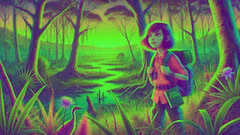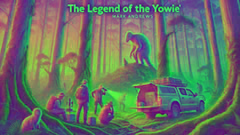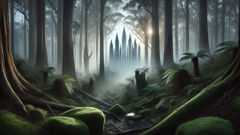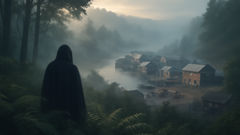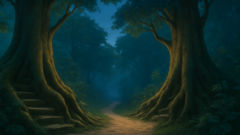Introduction
Twilight slips through the ancient myrtle forests of Tasmania, painting the land in silvery blues and mossy greens. Here, beneath the watchful gaze of cloud-wreathed mountains and in the shadows of ferns as old as time, the island’s wild heart beats on—restless, untamed, and full of stories. Among the oldest and most persistent is the legend of the Thylacine, the so-called Tasmanian Tiger: a creature marked by its dog-like form, stiff tail, and a coat striped like the dusk-shadowed trunks around it. Official records say it’s extinct—gone since the last captive animal died in 1936 in a cold, concrete zoo. Yet, in the whispers of wind through eucalyptus groves, in the creak of branches at midnight, and in the eyes of those who still roam the island’s wilderness, the Thylacine endures. Its memory lingers in painted cave walls and settler diaries, in the anxious hope of scientists and the deep certainty of bushmen who have seen a striped shadow flicker across their headlights or vanish at the forest’s edge. For Tasmania, the Thylacine is more than a lost predator—it’s a myth woven into the soil, a symbol of both irretrievable loss and wild possibility. People come here searching: some with camera traps and field journals, others with childhood dreams. They ask: Could something so rare, so remarkable, have truly slipped away forever? Or does the Thylacine still slip between tree ferns, haunting the borders of certainty and myth? This is a story of vanishing and survival, of how a creature hunted to extinction became an icon of hope and warning—a tale as tangled and evocative as the Tasmanian wilderness itself.
Whispers in the Wild: Origins of the Thylacine Legend
Long before European ships braved the Roaring Forties and sighted the dark shape of Tasmania on the horizon, the Thylacine was king of these shadowed woods. To the Palawa—the island’s first people—the animal was neither myth nor monster but a respected presence, a hunter like themselves. In their stories, the Thylacine was known as the coorinna, a silent mover by moonlight and a cunning spirit of the bush. Cave paintings and ochre marks on dolerite cliffs bear silent witness to this relationship: a slender, striped figure running alongside kangaroos and wallabies, sometimes depicted with a glowing orb or surrounded by spirals that evoke the swirling mists of the highlands.

The first colonial accounts were tinged with anxiety and awe. Early settlers described a creature that looked part dog, part tiger—its stiff tail and distinctive stripes setting it apart from any European beast. Livestock vanished, and the Thylacine’s reputation as a sheep-killer quickly outgrew its actual impact. Bounties were offered, and soon the forests rang with the crack of rifles and the snap of traps. Yet the more settlers hunted, the more elusive the Thylacine seemed to become. Tracks appeared overnight in muddy riverbanks only to vanish at dawn. Dogs refused to follow its scent. Some whispered that the Thylacine could melt into the shadows or slip between worlds, never to be caught.
Still, sightings continued. In 1830, an old trapper named Seth Armitage claimed to have watched a Thylacine female emerge from the brush, her coat rippling with stripes that shimmered in the early sun. She paused, nose twitching, then vanished so swiftly that Seth wondered if he’d seen a ghost. In journals and letters, settlers confessed to strange encounters—a glimpse of movement at the edge of vision, yellow eyes reflecting firelight, an eerie cry echoing through the valley at midnight.
As the years passed, the Thylacine’s legend deepened. Farmers cursed it, children feared it, and bushmen respected its uncanny knack for survival. Even as bounties decimated their numbers and disease ravaged their kind, rumors persisted of a last pack roaming the Tarkine or a lone male stalking the Franklin River. The Thylacine had already begun its transformation: from living animal to legend, from hunter to haunting. Its name became a byword for the wildness of Tasmania itself—a mystery that could not be tamed or explained away.
Lost and Found: The Last Thylacine and a Century of Sightings
By the time the 20th century dawned, the Thylacine had become a fugitive from its own homeland. The last confirmed wild animal was shot in 1930, its pelt dragged into town as a grim trophy. In 1936, Benjamin—the final known Thylacine—died alone in Hobart Zoo, shut outside on a cold night. Newspapers published mournful headlines, and the world mourned the passing of a species. But Tasmania itself didn’t quite believe the story was over.

Within weeks of Benjamin’s death, reports began to trickle in from the wilderness. A timber cutter near Waratah claimed he’d startled a striped animal drinking at the creek. Two hikers saw something that looked like a Thylacine slink through the button grass near Lake Pedder. Most sightings were fleeting—just a flash of stripes or a tail disappearing into the manuka scrub. Authorities dismissed them as mistakes, misidentification, or wishful thinking. Yet the stories multiplied, passed from one bushwalker to another, gathering detail and conviction with every telling.
As decades turned, the Thylacine became a kind of folk hero: a symbol of what Tasmania had lost but refused to let go. The government declared it officially extinct in 1986. Yet in that very year, a park ranger named Jodie Bramwell found herself face-to-face with a creature unlike any she’d ever seen while driving through the Weld Valley at dawn. It paused before her headlights—long, slender, striped from shoulders to haunches. She fumbled for her camera, but the animal vanished as quickly as it had appeared. Jodie’s report was met with polite skepticism, but locals nodded knowingly. "They’re out there," they’d say, lowering their voices. "Always have been."
The media took notice. TV crews set up camera traps, and amateur naturalists combed the southwest’s rainforests. Occasionally, grainy footage or blurry photographs surfaced—a striped back crossing a fire trail, a shadowy shape in the undergrowth. Most were easily debunked; a few remained tantalizingly unexplained. Yet for every photograph, there were a hundred stories: a farmer who found strange tracks in his paddock; a botanist who heard a low, coughing bark while camping by the Arthur River; a child who swore she’d seen a tiger drinking from her family’s rainwater tank.
Meanwhile, the Thylacine’s legend grew in the public imagination. It became a motif for conservationists fighting to protect what remained of Tasmania’s wild places. Artists painted it stalking through ghostly forests; writers spun tales of last survivors eluding pursuers. In shops and markets, its image appeared on souvenirs and stickers—sometimes fierce, sometimes melancholy, always elusive. With every story told and retold, the Thylacine stepped further into the realm of myth, yet remained stubbornly tethered to the possibility of truth.
Hope in the Shadows: The Thylacine as Tasmania’s Symbol
In Tasmania’s cities and towns, the Thylacine is everywhere. Its striped silhouette graces road signs and beer labels, postage stamps and football jerseys. Tourists arrive with questions, locals respond with stories—and always, there’s the undercurrent of longing. For many Tasmanians, the Thylacine is not just an animal lost to history; it’s a reminder of wildness and fragility, of mistakes made and lessons to be learned.

This symbolic power has made the Thylacine a rallying cry for conservation. In the aftermath of its extinction, Tasmania awoke to the vulnerability of its other unique creatures: the devil, the quoll, the swift parrot. Campaigns to save ancient forests often invoke the ghost of the Thylacine—a warning of what can happen when greed and short-sightedness trump respect for nature. Environmentalists march under banners emblazoned with stripes, and schoolchildren recite stories of tigers lost and maybe, just maybe, tigers yet to be found.
Yet the legend is not without its controversies. Some bristle at what they see as a myth distracting from more pressing ecological work; others believe that clinging to the hope of rediscovery undermines efforts to protect living species. But for most, the Thylacine is a complicated emblem: a reminder that extinction is forever, but that mystery and wonder still have a place in the world.
Occasionally, hope flares anew. In 2017, a pair of men in a remote part of the Tarkine claimed to have filmed a Thylacine crossing a logging track. The footage was inconclusive—just a blurred form in a sea of green—but for days, Tasmania buzzed with excitement. Scientists dissected the video frame by frame; bushmen compared it to their own tales. For every skeptic, there was someone who believed. In cafes and country pubs, people talked of old sightings, of family stories passed down through generations. The Thylacine was alive—not just in the forests, perhaps, but in the collective heart of Tasmania.
In this way, the Thylacine persists. It is both ghost and hope, absence and presence. Its legend ties together past and present, science and folklore, grief and wonder. And as long as stories are told beneath the shadowed boughs of Tasmania’s ancient forests, the Thylacine’s spirit will never be truly lost.
Conclusion
The story of the Thylacine is not just one of extinction—it’s a story of longing, resilience, and the wild edges of possibility. Each time a shadow slips through the tea tree thicket or strange tracks appear on a muddy path, Tasmania’s people remember what’s been lost and what might still endure. The Thylacine lives on: not only in fading photographs and museum specimens, but in dreams, legends, and the daily pulse of the island’s wild heart. Whether it’s gone forever or still prowling beneath ferns at dusk, the Tasmanian Tiger remains a powerful reminder of nature’s fragility and resilience. Its legend urges us to care more fiercely for what survives, to wonder at what lies just beyond sight, and to honor the mysteries that make our world richer and more profound. For as long as there are forests shrouded in mist and voices willing to tell its tale, the Thylacine will remain—half-ghost, half-hope—Tasmania’s eternal enigma.


